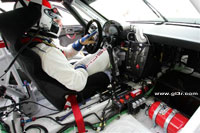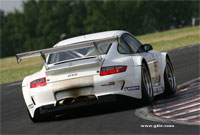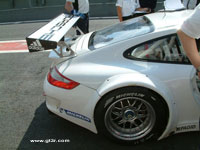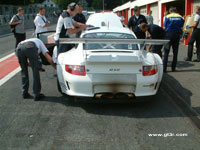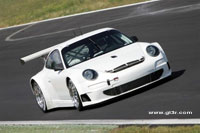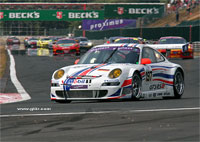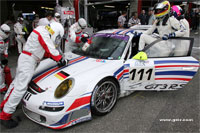99 | 00 | 01 | 02 | 03 | 04 | 05 | 06 | 07 | 08 | 09| 10
2006 GT3 RSR specfications
Concept
Porsche 911 GT3 RSR
single-seated GT race vehicle.
in accordance with the 2006 ACO LMGT2 Regulations and the 2006 FIA Article
257 (Technical Regulations for Series Grand Touring Cars).
basis: Model Year 2007 Porsche 911 GT3 RS (997; street legal version).
Engine
Six-cylinder aluminum boxer engine, water-cooled.
3,795 cc, stroke 76.4 mm, bore 102.7 mm.
max. power: 358 kW (485 bhp) at 8,400 rpm.
max. torque: 435 Nm at 7,250 rpm.
air restrictors 2 x 30.3 mm.
max. rpm: 9,000 rpm.
four-valve cylinder heads.
oil-water heat exchanger.
dry-sump lubrication system with engine mounted dry-sump tank made from carbon
fiber.
oil and cooling water refilling system.
intake manifold made of carbon fiber with dual air restrictors and single
throttle per cylinder, dual restrictor.
electronic engine management system BOSCH MS 4.0.
required fuel quality: 98 octane ROZ, unleaded
race exhaust: multiple pipe manifold, open exhaust, no catalytic converter
Power Train
Six-speed sequential dog type manual transmission, straight cut gears re-designed
for optimized drive shaft angle.
"in-line" shift mechanism, sensor controlled traction interruption.
oil-water heat exchanger.
single-mass flywheel with triple-disc race clutch.
limited slip differential 40/60%.
rear-wheel drive.
Bodywork
weight optimized and widened 911
GT3 RS chassis (add-on parts made from carbon/kevlar fiber)
welded-in roll cage.
racing seat (driver side only) with fire retardant upholstery, weight optimized
six-point seat belt, prepared for using HANS Safety System (Head And Neck
Support System).
three-point air jack system.
aerodynamically optimized front and rear part.
flat underbody made from carbon fiber.
adjustable rear wing.
removable steering wheel (quick-connect coupling).
fire extinguishing system.
100 litre FT3 safety fuel tank with quick refuelling system.
Vehicle Weight
approx. 1,225 kg
Suspension
McPherson front axle with unibal joints and corresponding
changes of kinematics
adjustable front roll bar, blade type
power steering
multilink rear suspension with unibal joints and corresponding changes of
kinematics
adjustable rear roll bar, blade type
double coil springs in front and rear adjustable in four different positions
front and rear struts with adjustable Sachs shock absorbers
suspension continuously adjustable (heights, camber, track)
Rims/Tires
Front axle: three-piece BBS light
aluminium rims 11J x 18 with central locking wheel nuts
Rain tires 27/65-18
Rear Axle: three-piece BBS light aluminium rims 13J x 18 with central locking
wheel nuts
Rain tires 31/71-18
Brake System
without ABS, dual master cylinders,
brake force balance adjustable by bias bar system
six-piston fixed brake callipers in the front
weight-optimized internally vented brake discs; 380 mm diameter
four-piston fixed brake callipers in the rear
weight-optimized internally vented brake discs; 355 mm diameter
Electrics
Bosch MS 4.0 engine management
Motec display with integrated data recording
battery: 12 Volt, 50 Ah
additional ventilation for driver (fan)
110 Ah generator
wiring harness prepared to accept A.C.O. stack data logging system
2006 Production Figure - 2 prototypes
Background
Porsche Press Release in Fall 2006:
"Based on the current 911 GT3 RS, a particularly light and sporty derivative
of the 911 GT3, the new GT3 RSR is designed to comply with the A.C.O (Automobile
Club de lOuest), the FIA-GT and IMSA (International Motorsports Association)
as well as VLN (Veedol Langstrecke Nuerburgring) regulations. Porsche decided
to build the new GT3 RSR after analysing the A.C.O. and FIA regulations in
a specification which allows a minimum weight of 1,225 kilograms (predecessor:
1,125 kgs) and permits the tyre width to be increased by two inches to now
14 inches. 35 kilograms of the required additional weight may be placed as
ballast in the vehicle, contributing to a lower centre of gravity.
For the normally-aspirated Porsche engine this specification allows a capacity
of 3.8-litres with two 30.3 millimetre air restrictors (predecessor: 3.6-litres,
two restrictors with 29 mm diameter). The increase in displacement was achieved
through the enlargement of the bore to 102.7 millimetres with the unchanged
stroke of 76.4 mm. With the mandatory air restrictors, the unit delivers 359
kW/485 hp at 8,500 revs per minute. Maximum torque increased to 435 Nm. Top
engine speed is reached at 9,000 rpm. Thanks to the increase in capacity and
the corresponding reprogramming of the electronics the top performance as
well as the response and driveability have further improved. The efficiency
of the mid-front radiator was increased while the radiators flanking the centre
unit on each side are the same as in the high performance Carrera GT.
The latest GT3 RSR features the proven sequential six-speed gearbox with ignition
cut of its forerunner.
The bodyshell of the GT3 RSR with the welded-in safety cage is ten percent
stiffer than its predecessor. Distinctive wheel arches widen the body by 50
millimetres on each side. The track is enlarged correspondingly; wheels and
tyres of the maximum allowable dimension can be fitted.
The relocation of the supplementary oil tank (option), the power steering
and the battery to the front improve the weight distribution. The front and
rear lids, the front mudguards, the wider rear, the doors as well as the front
and rear panelling and wing consist of carbon-fibre composite material. The
rear and side windows are manufactured from light polycarbonate.
The newly-developed aerodynamic package improves the aerodynamic efficiency
compared to the forerunner (type 996 GT3 RSR) by around seven percent. Airflow
to and from the radiators, the brakes and the engine were further optimised.
In compliance with the FIA and A.C.O. regulations the new GT3 RSR features
a flat underbody.
The suspension with Porsche-optimised struts at the front and the Porsche
multi-link axle at the rear corresponds to the configuration of the standard
car. The modified kinematics are set-up for the wider tyre footprint and for
the lowest possible camber change in rebound and compression. The new ZFSachs
shock absorbers feature the Through-Rod-System with considerably lower chamber
pressure and hence less friction than conventional dampers. As a result they
offer a significantly improved response characteristic. The position of the
rear axle was optimised. The axle features a new anti-rollbar, an adjustable
upper link and an optimised lower link.
The brake system features six-piston aluminium callipers and 35 millimetre
thick brake discs measuring 380 mm in diameter at the front and 30 millimetre
four-piston aluminium callipers with 355 mm diameter discs at the rear.
Over the 2006/07 winter, 35 units of the new racing sportscar will initially
be built."


